Learn about the history of the 13th Foreign Legion Demi-Brigade (13e DBLE), the last demi-brigade within the current French Army. The text maps the period from its beginnings in Algeria in early 1940 to the early 2020s in France. The unit fought in Norway, Africa, the Middle East and France during WWII, when it was in service of both the French and British Empires. After the war, the demi-brigade took part in campaigns in French Indochina and North Africa’s Algeria. From 1962 to 2011, it maintained French presence in the Horn of Africa, in Djibouti. Thereafter, a considerably reduced unit, the 13e DBLE moved first to the United Arab Emirates, then it was reorganized in France into a brand-new infantry regiment. Read more in the following article…

13th Demi-Brigade: Activation and France
In early September 1939, Hitler’s Germany invaded Poland. As a result, Britain and France responded by declaring war on Germany. In late November, Stalin’s Soviet Union (USSR) invaded Finland and the Winter War began. Britain and France planned to support the Finns, and so in early 1940, the French command decided to create a new unit within the Foreign Legion, intended to fight in cold Northern Europe.
Following this decision, two battalions were formed in French North Africa starting on February 20, 1940. One began in Algeria, within the then Legion’s HQ, from men of the 1st Foreign Regiment and DCRE. The second battalion was organized in Morocco, with the men coming from the 2e REI, 3e REI and 4e REI. In early March, the two battalions constituted a Mountain Light Infantry Demi-Brigade (DBLMLE), a mountain warfare unit which was trained and equipped like the common chasseurs alpins units (Alpine Hunters in English) of the French Army. Lieutenant Colonel Raoul-Charles Magrin-Vernerey took command.
The new demi-brigade was immediately sent to Camp Larzac in France, where the legionnaires were to receive mountain training and equipment. However, following the Moscow Peace Treaty of March 13, the Winter War was declared over. Thus, the DBLMLE’s Finland mission was cancelled. Two weeks later, on March 27, the unit was redesignated and became the 13th Foreign Legion Provisional Demi-Brigade (13e Demi-brigade de Marche de Légion Etrangère, 13e DBMLE). In April, the 13e DBMLE moved to the Belley region to continue their mountain warfare instruction.
Some may wonder why demi-brigade and 13 are in the unit’s title. The answer is simple. The Legion’s demi-brigade got its name partially because it was smaller than the usual three-battalion infantry regiment (two-battalion units were often called demi-brigades in France), and partially due to the fact that all mobilized French chasseurs alpins units were organized as demi-brigades. Regarding the number, 13 was chosen because two other Foreign Legion provisional units had already been formed: the 11e REI and 12e REI.
13e DBMLE: 1940 Norwegian Campaign
In the meantime, the British chose to land in neutral, but strategically important Norway and occupy its port of Narvik. Through this ice-free port came large quantities of Swedish iron ore, on which Nazi Germany was vitally reliant. To thwart the British plan and secure the strategical flow of Swedish iron ore, the Germans launched their own successful invasion of Norway, which started on April 9. Narvik would be occupied, among others.
Britain and France quickly reacted. The men of the 13e DBMLE, distinguished from the rest of the Legion by their khaki wool berets (common headgear for chasseurs alpins), became part of the French Expeditionary Force in Scandinavia (CEFS) under General Béthouart. On April 22 they were sent to Norway, alongside another two French demi-brigades of chasseurs alpins and a 5,000-man strong Polish contingent under General Bohusz-Szyszko.
In April, Britain’s Royal Navy was engaged in two successful naval battles at Narvik. However, deprived of landing forces, the port remained occupied by Germans. In May, a mainland battle also occurred there, in which the Allied troops – consisting of around 24,500 men under Admiral of the Fleet Lord Cork – faced some 5,500 Germans.
In the night and early morning of May 12–13, following a heavy naval bombardment, the 13e DBMLE legionnaires successfully attacked and seized Bjerkvik (spelled Bjervik by the French), a village located north of Narvik. The Allies now had a clear path to the port. This was the first French battle won over German forces in the Second World War. However, the unit also reported its first casualties; eleven men were killed. Among them was Lieutenant René Maurin, the very first officer of the 13th Demi-Brigade to be killed in action. Three days later, in an attack carried out by German aircraft on Legion positions, the demi-brigade also lost Major Alain Gueninchault, 2nd Battalion commander, as well as Captain Francois Carre de Lusancay and twelve legionnaires.
Their revenge came on the night of May 28–29. Once again preceded by a naval bombardment, the two Legion battalions – supported by Norwegian and Polish troops – launched a new assault, this time on Narvik itself. After several hours of fierce fighting, the town was captured for the Allies. The 13th Demi-Brigade suffered 31 dead, including three officers; 41 officers and legionnaires were wounded. Despite these losses, the Battle of Narvik became the first major Allied victory on land in WWII.


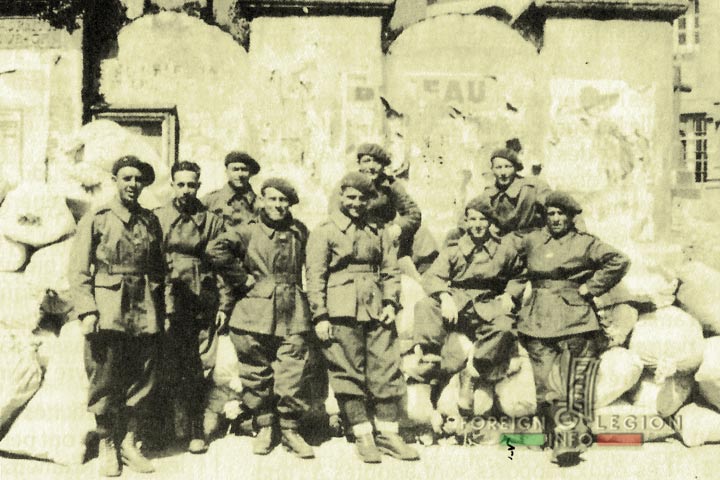


13e DBMLE: England and separation
But the course of the war changed. Since May 10, France had faced rapidly advancing German troops. The campaign in Norway was therefore stopped on June 10 and the captured positions were abandoned. Two weeks later, France capitulated. The Expeditionary Corps, including the 13e DBMLE, headed for England.
There, in late June, General de Gaulle – who had earlier fled France for England – gave a speech in which he called on French troops not to recognize the French capitulation, but to continue the war alongside the British Empire instead. However, the speech didn’t provide the result he might have expected. Out of the 14,000-man French expeditionary corps, the vast majority chose to return to France and North Africa. Nevertheless, some 1,300 men did decide to leave the French Army, stay in England and continue to fight against Germany under General de Gaulle.
Among these “Free French Forces,” as they would call themselves, were about 900 men (one battalion) of the 13e DBMLE. The majority were volunteers who had recently escaped Hitler and joined the Legion to fight him: mainly Spanish republicans, Czechs, Poles, and Jews.
On July 1, these men became the 14e DBMLE to avoid confusion with the original unit. Lieutenant Colonel Magrin-Vernerey kept the command, but changed his name to Raoul Monclar. This practice was followed by all officers to hide their real identities from French authorities.
Meanwhile, the original 13e DBMLE returned to Morocco to be dissolved there on July 16. These men subsequently rejoined their former units in Morocco and Algeria.
14e DBMLE, 13e DBLE: Africa and the Middle East, 1940–1941
On August 31, having just come under the command of Lieutenant Colonel Alfred Cazaud, the demi-brigade left England for West and Equatorial Africa, where they would face French colonial troops in what were then the French colonies. First was Senegal with the unsuccessful naval Battle of Dakar, then Cameroon, which voluntarily rallied to the Free French. Finally came Gabon in November, where the men first were fighting with French troops and then with the moral repercussions for sure… That same month, the unit adopted its original number and became simply the 13e DBLE, without the word “provisional.”
The year of 1941 marked military campaigns in East Africa and the Middle East, alongside British forces. Between February and April 1941 it was the Eritrea campaign in Italian East Africa, where the victorious battles of Keren and Massawa (Massaouah in French) were fought against the Italian army. In May, the 13th Demi-Brigade moved to the Middle East. They went first to Palestine, then to French Syria (for the Syria-Lebanon Campaign), where they once again encountered French troops, including legionnaires from the 6e REI. The numerous defections of imprisoned French troops and 6e REI legionnaires allowed the single-battalion demi-brigade to be reorganized into three battalions (called Foreign Legion Battalions or BLE).
In mid-September, Lieutenant Colonel Dimitri Amilakvari took over the unit, which finally received its flag on October 19 in the Syrian city of Homs.

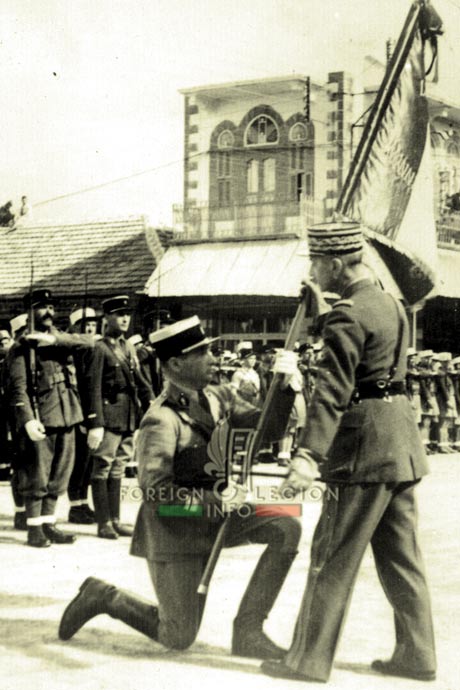
13e DBLE: Libya and Egypt, 1942
In December 1941, two battalions of the demi-brigade (the 2nd and 3rd) were assigned to General Koenig’s 1st French Brigade for the Libyan campaign, where the British were preparing an offensive to push the Germans out of Africa. From May to June, the 13e DBLE staged the heroic defense at Bir Hakeim, where its battalions stopped the advance of General Rommel’s German Africa Corps. Due to their huge losses, these two battalions then merged into one, the 2nd; the latter was thereafter rejoined by the 1st Battalion.
In October 1942, the Second Battle of El Alamein was fought in Egypt; this was the first major offensive of the Allies against the German and Italian forces since 1939. However, the successful battle was marked by the sad death of Lieutenant Colonel Amilakvari, who was killed on October 24.
BLEs: Tunisia and Libya, 1943–1944
Reunited within the 1st Free French Division (1re DFL) in early 1943, the two Foreign Legion Battalions – now autonomous because of the recent administrative deactivation of the 13th Demi-Brigade – crossed Libya and took part in the Tunisian Campaign against Germans and Italians. Other Foreign Legion units also participated, since French North Africa had already joined the Allies in late 1942. The successful campaign lasted until mid-May.
Between July 1943 and April 1944, the two battalions (as well as an anti-tank company, called CAC 13) were stationed in Libya, along with the 1re DFL. At the same time, in mid-1943, the Free French units left the British service and merged with the French Army of Africa.
13e DBLE: 1944 Italian Campaign
In April 1944, the two battalions of the freshly reactivated 13e DBLE, now under Major Gabriel Bablon, left Africa for Southern Europe as part of the French Expeditionary Corps in Italy. Until June, the legionnaires saw fierce battles on their route from Naples to the fortress of Radicofani, north of Rome. They were often delayed by enemy counter-attacks, but never stopped. In Italy, 17 officers, 171 NCOs and legionnaires were killed.
At the time, first drafts from the Foreign Legion HQ in Algeria were reinforcing the demi-brigade, which could be seen as the recognition of the unit as an official part of the Legion.
13e DBLE: Liberation of France, 1944–1945
In August 1944 came Operation Dragoon, the Allied invasion of Provence in Southern France. The 13e DBLE, still wearing their khaki berets, partook in the Liberation of France alongside the Foreign Legion Regimental Combat Team (RMLE, under the flag of 3e REI) and the 1er REC. On their way to the northeast, the battalions of the 13e DBLE fought for each city: Toulon, Avignon, Lyon, Autun, and others. In October, the 3rd Battalion (3e BLE) was reactivated.
In November, the demi-brigade under Lieutenant Colonel Paul Arnault fought in the Battle of the Vosges, a range of low mountains in the Alsace region of Eastern France. In late December, the unit was sent across the whole country on the Atlantic coast in Southwestern France to take part in reducing the German fortified position at the Pointe de Grave.
January and February 1945 saw the 13th Demi-Brigade men’s help to break through enemy lines and reduce the Colmar Pocket, again in Alsace, that was held by the German 19th Army. During the operations in Alsace, the unit lost 32 officers, 761 NCOs and legionnaires killed or wounded.
Once the Rhine was reached, it was necessary to return to the south of France to reduce the enemy in the Authion massif, bordering Italy. This is a whole series of peaks exceeding 6,500 feet (2,000 meters), crowned with fortified works. This last effort took the demi-brigade (who had now been under Lieutenant Colonel Bernard Saint-Hillier since March) all the way to Italy where it was only halted by Germany’s unconditional surrender on May 8, 1945. This marked the end of WWII in Europe.


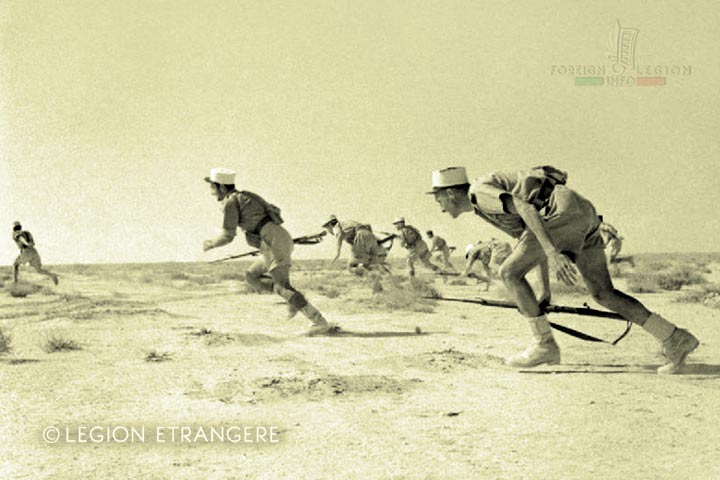




13e DBLE: First Indochina War
Arriving in Tunisia in August 1945, the 13e DBLE set about filling the huge gaps in its ranks, a testimony to the heavy toll paid in the liberation of France. But other battles were already waiting for the unit. On December 15, it was designated to be part of the French Expeditionary Corps in the Far East. Their objective was French Indochina in Southeast Asia.
At the time, French Indochina (Vietnam, Cambodia, and Laos) was in a period of transition of power between different forces. In March 1945, the Japanese drove the French out and subsequently occupied the territory until August of the same year, when Japan’s capitulation ended WWII. Cambodia and Laos, which had become puppet states controlled by the Japanese, were now being transformed into pro-French kingdoms again, and occasionally harassed by local anti-French guerrilla.
In Vietnam – which until March 1945 consisted of France’s Tonkin and Annam protectorates (what are now Northern Vietnam and Central Vietnam) and the colony of Cochinchina (Southern Vietnam) – the situation was more complicated. There were the communist-led Viet Minh independence movement of Ho Chi Minh and several smaller insurgent groups, the British and Chinese troops who were occupying Vietnam after August 1945, and the French, who had been slowly returning to their former colonial territories since October 1945. While the British and Chinese soldiers were leaving Vietnam during the first half of 1946, both the French and the Viet Minh were seeking a way to (re-)consolidate power in the region. Soon, the first armed clashes occurred between the two sides.
13e DBLE in Indochina, 1946–1949
In March 1946, the three battalions of Lieutenant Colonel Bablon’s 13th Demi-Brigade landed in Cochinchina and were stationed north of Saigon, the capital, with the HQ based at Hoc Mon. The legionnaires maintained order in the region by occupying local outposts and conducting patrols in their assigned sectors, as well as protecting French supply convoys on the main routes. This was particularly done on the RC1 colonial road going west from Saigon to Phnom Penh in neighboring Cambodia.
The region was far from calm. Two days after the 13e DBLE’s arrival in Indochina, two officers and two legionnaires were killed in an ambush. The first serious battle took place three months later, on June 19, at Mat Cat. A hundred rebels were killed that day.
In August, Lieutenant Colonel Gabriel Brunet de Sairigné took command of the demi-brigade and became, at 33, the youngest commanding officer of that rank within the French Army. He was a veteran of the unit, with whom he had served as a lieutenant as early as 1940.
While the 3rd Battalion operated in Cochinchina until late 1947, the 1st Battalion moved to Cambodia to face anti-French Khmer-lssaraks rebel groups, supported by Thailand. Meanwhile, in December 1946, the Viet Minh launched a general anti-French attack in Hanoi (the then capital of both Tonkin and French Indochina) and other cities across Vietnam. This was the start of the First Indochina War. The 1st Battalion returned to Cochinchina, and the 2nd Battalion was sent to Annam to defend Tourane (the capital) and free the important, encircled towns of Hue and Quang Tri. Then, alongside the Legion’s 1er REC, the battalion participated in operations south of Tourane, where it earned a War Cross.
In late 1947, the 3rd Battalion deployed to Cambodia for several weeks. In Cochinchina, operations continued; among them was Operation Vega in the Plain des Joncs, the wide tallgrass wetland of the Mekong Delta.
On March 1, 1948, Lieutenant Colonel Brunet de Sairigné, accompanied by his wife and a small daughter, was killed during a Viet Minh attack aimed at a French military convoy. The famous, popular officer was replaced by Lieutenant Colonel Paul Arnault. The latter, a veteran who had not left the 13e DBLE since February 1940, began to build a large headquarters at Hoc Mon, which would quickly be nicknamed Arnaultville.
In late 1949, the 2nd Battalion deployed from Annam to Tonkin for several weeks, before rejoining the two battalions in Cochinchina and ending their three-year separation.





13e DBLE in Indochina, 1950–1955
Meanwhile, the increase in the intensity of the fighting and a change in tactics by the French command led to the creation of a 4th (and sometimes even 5th) Battalion in each of the Foreign Legion infantry regiments, including the demi-brigade. These new battalions comprised local auxiliary, led by Legion cadres. The new situation was known as “yellowing” (jaunissement) of the French forces in Indochina. In the midst of these changes, the 4th Battalion 13e DBLE was activated in January 1950. Under Majors Creton and d’Agier de Rufosse, it served alongside the 1st Battalion in Cochinchina until late January 1953, which was the date of its dissolution and integration into a new pro-French Vietnamese Army.
In late February 1950, on its ten-year anniversary, the 13th Demi-Brigade under Lieutenant Colonel René Morel was awarded the Fourragère in the colors of the Foreign Theater Operations War Cross (blue/red). The award was handed over by General Monclar, the very first commander of the unit.
Following the late 1950 French retreat from the Northern Tonkin sectors bordering communist China, accompanied by the sad Battle of RC4, the 2nd and 3rd Battalions moved to Tonkin to participate in the construction of General de Lattre de Tassigny’s defensive line. This line consisted of a dense network of concrete fortifications and obstacles around the Red River Delta. Then, from November 1951 until early 1952, both battalions took part in the Battle of Hoa Binh. The 2nd Battalion legionnaires distinguished themselves with their heroic defense of the Xom Pheo outpost on the night of January 7–8, when 250 of them fought off around 5,000 Viet Minh troops.
The HQ, 1st and 4th Battalions of the 13th Demi-Brigade under Lieutenant Colonel Clément (and, after late 1952, under Lieutenant Colonel Guigard) still remained in Cochinchina at this time. Meanwhile, the 2nd and 3rd Battalions were mainly operating in the Tonkin Delta, carrying out missions that included Operation Mercure alongside the 1er BEP and Operation Bretagne alongside the 2e REI. The only exception was the several-month deployment of the 3rd Battalion to Central Annam in the second half of 1952, to support their comrades from the 1er REC and 5e REI.
Between February and May 1953, the 3rd Battalion was stationed in the western part of Tonkin, in the valley of Na San, where a fierce battle with three Viet Minh divisions had taken place in late 1952.
In July 1953, the 13e DBLE was awarded the Fourragère in the colors of the Military Medal. Still distinguished by their khaki berets, the men of the demi-brigade would wear the yellow-green fourragère from then onward.
Early September saw Lieutenant Colonel Jules Gaucher become the commanding officer of the demi-brigade. At the same time, the HQ and 1st Battalion left Cochinchina, having spent seven and a half long years there, and also moved to Tonkin. The HQ would now be based at Ha Dong near Hanoi. Meanwhile, the other two battalions continued their forays in the Tonkin Delta, including Operations Brochet and Mouette.
In December, the 1st and 3rd Battalions were sent to the valley of Dien Bien Phu, located in northwestern Tonkin, to build and occupy the Claudine and Beatrice strongpoints. In March 1954, the valley was fiercely attacked by the Viet Minh. In the ensuing Battle of Dien Bien Phu, Lieutenant Colonel Gaucher was killed and both 13e DBLE battalions were annihilated.
This decisive confrontation led to the end of the Indochina War in August of the same year. In October, the demi-brigade, now under Lieutenant Colonel Jean Rossi, was reunited with its freshly reconstituted battalions on the Do Son peninsula near Haiphong, an important port city in eastern Tonkin. The last French military unit to remain in what had been Tonkin and was now Ho Chi Minh’s North Vietnam, the 13e DBLE moved back to Cochinchina in May 1955 and was stationed at Cap Saint-Jacques near Saigon. However, the next month, the three battalions one by one left the former French colony and returned to North Africa.
During its nine years spent in Indochina, the 13th Demi-Brigade lost 80 officers (including two commanding officers), 107 non-commissioned officers and 2,334 legionnaires.
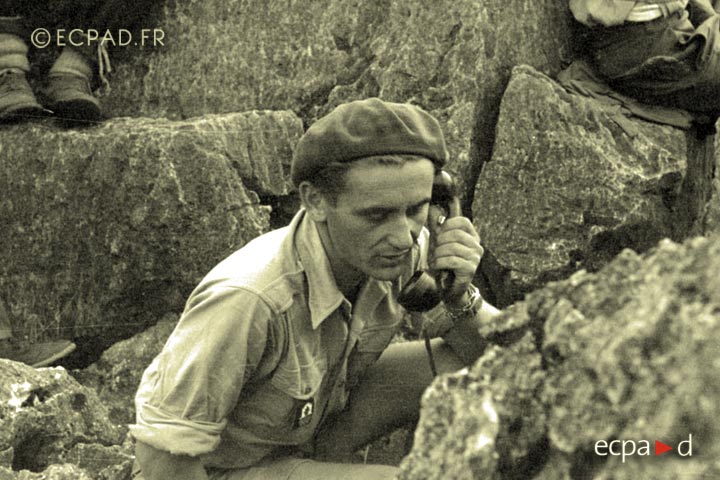

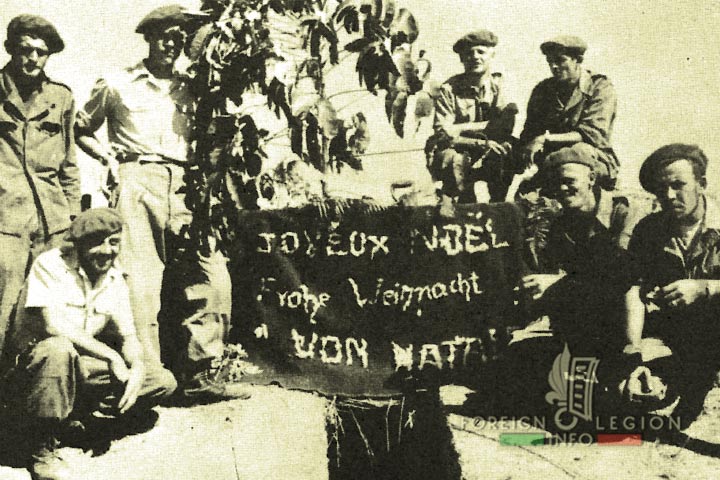


13e DBLE: Algeria, 1955–1962
Nevertheless, the situation had devolved considerably, even in French North Africa. The year 1954 marked not only the end of the war in Indochina, but also the beginning of hostilities in Morocco, Algeria, and Tunisia. As soon as they landed in Algeria in July 1955, the legionnaires of the 13e DBLE partook in operations to restore and maintain order in the country. First stationed at Zeralda with the 1er BEP, they later moved to the Guelma region in northeastern Algeria, then south to the Aures-Nementchas mountains: a harsh and deprived region that had been heavily affected by the insurgency. With their HQ based at the small, ancient town of Taberdga, the three battalions began a direct action against the rebels, who were mostly represented by the National Liberation Front (FLN) and its armed branch, the ALN.
While Morocco and Tunisia became independent during early 1956, the hostilities in Algeria developed into a full-scale war. The 13e DBLE carried out their assigned tasks, first under Colonel Marguet and later Lieutenant Colonel Senges; hundreds of rebels were killed in the sector.
In July 1957, the unit was reduced to two battalions. These were transformed into semi-independent operational task forces, called EMT (Etat-Major Tactique). Two months later, the HQ moved to Khenchela, a town located north of Taberdga.
In December, following the rule prescribed for all Legion infantry and cavalry regiments, a Harka was activated within the demi-brigade. This auxiliary group, all mounted on horseback, was made up of some 200 local pro-French Muslim Arabs called harkis. They were commanded by Lieutenant Robin Wrenacre, an English-born officer of Russian origin.
During their military operations that year, the men of the 13e DBLE killed 465 rebels. Then in May 1958, a local rebel leader named Amrani Abderrahmane was killed by the demi-brigade, along with his large FLN group. The rebels had been haunted by the legionnaires for two years.
In July, a small, abandoned, starving donkey was found by the 13e DBLE’s Harka. An iconic photo showing a harki carrying the animal on his back soon appeared in newspapers and magazines around the world. For that “demonstration of humanity,” the unit, as well as the Foreign Legion, was thanked and awarded a medal by the London-based Royal Society for the Prevention of Cruelty to Animals. The small donkey was given the name Bambi and became the mascot of the 13e DBLE.
In mid-October 1958, the unit began to serve as an intervention force for the whole Constantine department where it had been operating since late 1955, and moved to Batna. In late December, Major Vieules was killed while commanding EMT 2. A former member of the 1er BEP, he became the highest-ranking officer of the 13th Demi-Brigade killed in Algeria.
In early 1959, the rear base of the unit, now under Lieutenant Colonel Robert Roux, was transferred to Bougie, a port city in the Kabylie region on the Mediterranean coast. Also in 1959, light khaki berets of the 13e DBLE (as well as the 1er REC) were abolished in October. The men had to adopt the green beret of the Legion paratroopers, which was prescribed for the entire Legion from then on. As for the light khaki berets, they had replaced the previous dark khaki ones since 1955 and were worn in Algeria during operations instead of the kepi.
From 1959 to 1961, important large-scale operations were carried out in the north as well as the south of the department, mainly along the border with Tunisia (the so-called Challe Line aimed at the rebels crossing the border). Between January and March 1960, the demi-brigade patrolled the streets in Algiers, the capital, before returning to the Tunisian border in Northeastern Algeria. In late 1960, six Legion regiments were involved there in operations alongside the 13e DBLE.
With the rear base in Bougie and the forward HQ based first at Bou Hamama, then at Souk Ahras and later at Hammam des Beni Salah, the demi-brigade carried out patrols and defense operations at the Challe Line until early 1962. Meanwhile, in March 1962, the Évian Accords ended the Algerian War, in which the regiment had lost 214 men.

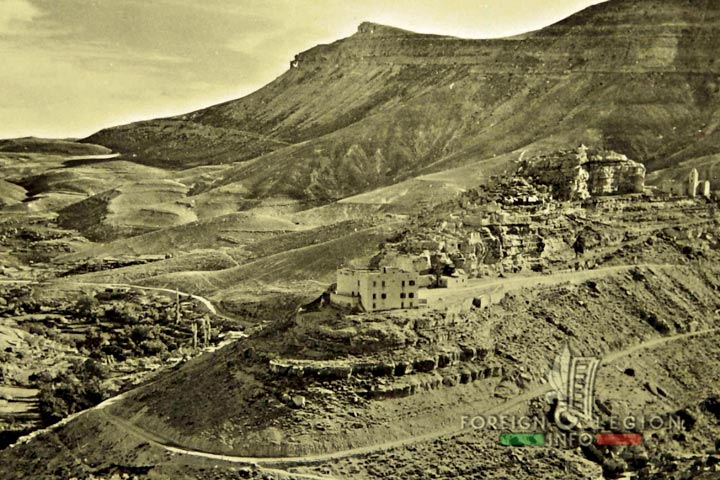









13e DBLE: Djibouti, 1962–2011
French Somaliland and TFAI, 1962–1977
France’s loss of Algeria led to the reorganization and significant reduction of the French armed forces, including the Legion. The 13e DBLE in Algeria was cut in half and its Harka dissolved. Thereafter, starting in May 1962, the HQ and three remaining companies of the demi-brigade began to be transferred to French Somaliland (present-day Djibouti), then a French territory in the Horn of Africa bordering Somalia, Ethiopia, and the Red Sea. The unit was fully re-established there in October, with the HQ at the Gabode Camp in Djibouti City, the capital, and its companies occupying outposts at Oueah, Obock, Ali Sabieh, Holhol (also Holl-Holl), and later at Dikhil and Arta.
A company of the freshly disbanded BLEM (Legion Madagascar Battalion), previously deployed in the same territory, merged with the demi-brigade and became its 1st Company.
In the deserted French Somaliland, the 13th Demi-Brigade served a dual security and public works role. For most of the 1960s, its legionnaires patrolled the borders, maintained order, and built military and public infrastructure. In the meantime, the demi-brigade had administratively transformed from an ordinary, organic unit into an overseas one with rotating personnel, but with far better monthly salary. That meant that now, the men came in by their own request from different Legion regiments and rotated on a regular basis under a two-to-three-year individual stay assignment.
A serious accident occurred near Obock in early November 1965, when a French military aircraft crashed; among three dozens of victims were Lieutenant Saint-Yrieix and Staff Sergeant Hopfe from the 13e DBLE.
In late August 1966, the unit provided a security force for French President de Gaulle while he visited the territory. During the following riots in the capital, 11 legionnaires were injured.
In June 1967, French Somaliland was renamed and became the French Territory of the Afars and the Issas (TFAI).
The Reconnaissance Squadron (ER) was activated within the demi-brigade at Oueah in February 1968, with former 1er REC cavalrymen. The 2nd Construction Company (CT), an engineering unit, also replaced the previously disbanded 2nd Company in February 1970.
In October 1974, another unit reinforced the 13e DBLE: the Rotational Company (Compagnie Tournante). This company comprised elements of the 2e REP which usually rotated every 4-6 months. They primarily patrolled the border with Ethiopia and were trained in desert warfare.
In early February 1976, snipers and cavalrymen from the 13th Demi-Brigade took part in the successful Loyada Hostage Rescue Mission, which freed a group of French children kidnapped by Somali rebels.
Later that year, on May 24, six legionnaires of the GOLE were killed in a helicopter crash during a military exercise.
In late June 1977, the TFAI territory gained its independence from France and became Djibouti (also known as the Republic of Djibouti). However, strong ties would be still maintained with Paris and thus the French military, including the Legion’s demi-brigade, were allowed to remain stationed on the territory.







13e DBLE in Djibouti, 1977–2011
As a consequence of the country’s independence, the 1st Company was disbanded in August 1978. The activities of the rotational unit were also interrupted from mid-1977 until October 1978. Upon the return of the 2e REP’s men to Djibouti, the Rotational Company was stationed at the freshly established Arta Beach Amphibious Center (CAA).
In October 1979, another reorganization occurred in the 13e DBLE. The 4th Company was disbanded, while the 3rd Company became a specialized unit with its platoons focused on different combat techniques: sabotage and handling of explosives, combat divers, and snipers. Apart from the Squadron in Oueah and the Rotational Company at Arta, the demi-brigade’s HQ and two companies (the 2nd and 3rd) were reunited in the Quartier General Monclar (Gabode Camp).
The Mont Garbi accident took place in Djibouti in early February 1982, in which a 2e REP platoon and two 13e DBLE members perished in a crashed aircraft.
The same year, the Grand Bara race was launched. The almost 10-mile (15 km) run was organized by the 13e DBLE and took place in the vast Grand Bara Desert near Dikhil, Djibouti. Soon, the race became international, with participation of the soldiers based on the territory – from France, the U.S., Japan, Germany and Djibouti – as well as nationals or runners from around East Africa, including civilians. The race has been organized annually ever since.
Also in 1982, the CAA amphibious center at Arta became the Arta Beach Commando Training Center (Centre d’Entraînement Commando d’Arta Plage; CEC, later CECAP). The famous center provided commando-like courses, first for the 13e DBLE and the 2e REP and thereafter for other French Army units deployed to the region, as well as Djiboutian soldiers and foreign troops, mainly U.S. elements.
In the early 1990s, the 2e CT was reinforced by the two combat support platoons of the demi-brigade (120 mm Mortars and MILAN anti-tank missiles), which had until then been assigned to the HQ Company. The reinforced unit became the 2nd Construction & Combat Support Company (2e CAT).
Following the end of the Cold War, with the changes in geopolitics, new operational activities appeared for the 13th Demi-Brigade in the region. In 1991, its men were involved in the humanitarian Operation Godoria to aid several thousand Ethiopian refugees who had sought safety in Djibouti: this included disarming an Ethiopian division which had also crossed the border. In 1992 the legionnaires performed Operation Iskoutir, which was carried out in support of the Djiboutian government against FRUD front rebels during the Djiboutian Civil War (1991–94); the operation lasted until the late 1990s. In December 1992, Operation Oryx began in Somalia and was undertaken alongside U.S. Marines, during which the well-known Black Hawk Down incident took place. The demi-brigade legionnaires likewise participated in the United Nations’ follow-up Operation UNOSOM (ONUSOM in France).
In May 1994, during the Yemeni Civil War, the 13e DBLE men were evacuating French and European nationals from Yemen to Djibouti (Operation Diapason). Later that year, the unit’s combat and engineering elements deployed to Rwanda in Central-East Africa as part of the humanitarian Operation Turquoise.
June 1996 saw the 13e DBLE awarded with the newly established Fourragère in the color of the Liberation Order (dark green), which had been proposed for all units of de Gaulle’s Free French Forces. The demi-brigade’s men have since worn two fourragères.
Two years later, the 2e CAT was disbanded and replaced by a rotational Engineer Company (CG), comprising a company either from the 6e REG (which became the 1er REG in 1999) or the 2e REG (since 1999). Another two years later, in July 2000, it was the turn of the 3rd Company, which had been a unique unit within the French Army due to its various specializations. After being disbanded, its combat tasks were taken over by the Infantry Company (CI), a former Rotational Company, newly comprising a company either from the 2e REP or the 2e REI.
In 2001, the Maintenance Company (CM) was attached to the 13e DBLE and based at Gabode Camp. A mixed unit consisting of regular French Army elements and legionnaires provided maintenance of vehicles for the French forces stationed in Djibouti.
In the 2000s, the 13th Demi-Brigade’s men once again participated in operational tasks outside Djibouti: Operation Licorne in the Ivory Coast (2002), Operation Beryx in Indonesia (2005), and Operation Boali in the Central African Republic (2007). The unit also provided training detachments (DIOs) to train soldiers in different countries of the region, including Ethiopia, Uganda, the United Arab Emirates, Qatar, and Kuwait.
However, the French forces in the Horn of Africa would eventually be reduced for political reasons. Thus, in mid-June 2011, the 13e DBLE left Djibouti, where it had spent more than 49 years. It was replaced there by the combined 5e RIOAM.
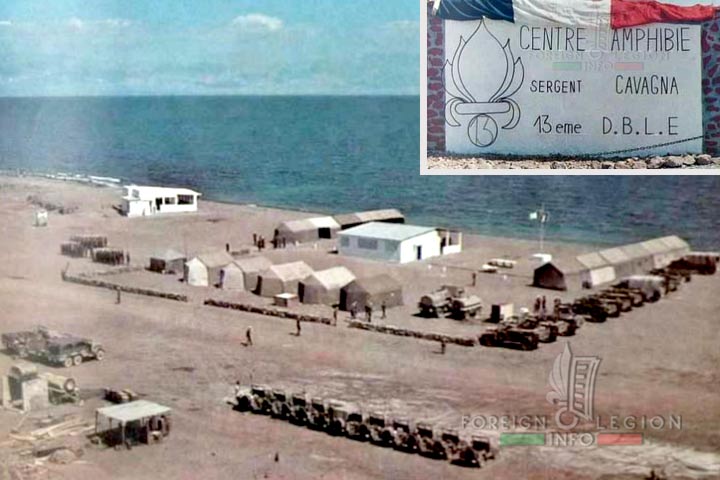











13e DBLE: United Arab Emirates, 2011–2016
Since early August 2011, the 13th Demi-Brigade had been stationed at the Zayed Military City near Abu Dhabi, the capital of the United Arab Emirates. The unit was fully reorganized and considerably reduced, with no more than 60 permanent Legion personnel (on 2-year stays) gathered in the HQ Company and about 200 elements serving in rotational units which rotated every four months. The latter were the Infantry Company (provided by the 2e REP or the 2e REI) and the CAESAR Detachment, a French artillery group operating 155 mm self-propelled howitzers.
Still considered an intervention force, the demi-brigade also ran the Middle East Hardening & Combat Training Center (CECAM) in the unit’s own military camp, with urban warfare facilities as well as the vast desert area nearby for desert training. Other of their tasks were similar to those in Djibouti: participating in major bilateral maneuvers in the region and, when needed, providing DIO training detachments (to Operation Chammal in Iraq in 2015, for example).
In 2013, 13e DBLE medical elements took part in the humanitarian Operation Tamour in Jordan, carried out to take care of the refugees and wounded following the Syrian civil war.
Nevertheless, the stay in the United Arab Emirates wasn’t of a long duration. A new future was being prepared for the demi-brigade in France, intended to give a more important role and form to such a prestigious unit. Therefore, in June 2016, the 13th Demi-Brigade left the Middle East and moved to France to once again become a fully operational regiment.
13e DBLE: France since 2016
Starting in mid-2015, a new unit was formed at Camp Larzac near Millau, in the Aveyron Department of Southern France. This was the same military camp at which the then freshly established demi-brigade had arrived from Algeria in March 1940, to go through instruction and get its official name. Seventy-five years later, the first elements of the new demi-brigade were being gathered there. They consisted of officers, NCOs and corporals from all over the Legion who had volunteered to become part of the new regiment, as well as fresh legionnaires who had just completed their basic training. Within a year, a demi-HQ and two combat companies had been constituted.
Thus, on June 29, 2016, a brand-new 13th Foreign Legion Demi-Brigade was officially activated at Larzac, under Lieutenant Colonel Guillaume Percie du Sert.
Assigned to the 6th Light Armored Brigade, along with three other Legion regiments, the new 13e DBLE is considered a modern motorized infantry regiment of the French Army, and has been equipped with a new generation of equipment. This includes the HK 416 rifle to replace the outdated FAMAS (since 2017; the 13e DBLE was the first among all French Army regiments to receive the rifle), and VBMR Griffon vehicles to replace the old VAB carriers (since 2021). The unit also took over what was then the Operational Shooting Training Center (CEITO), a long-time part of Camp Larzac, with its vast shooting range. The center was later renamed Level 2 Training Area Detachment (DEEN2) and was destined for use by French Army infantry and cavalry units, including of the Legion.
In 2017, already consisting of the HQ Company and four combat companies, the new demi-brigade first participated in a joint exercise, that time in North Carolina, United States. Similar exercises with the U.S. armed forces would continue even in later years, as well as around the world, including in Africa and Japan.
In 2018, the 13e DBLE achieved its full operational strength. The unit now comprised the HQ Company, five combat companies, a combat support company, a company of non-Legion elements operating the shooting range, and a reserve company with non-Legion reservists. All together, this counted around 1,300 personnel.
The same year, the 13th Demi-Brigade saw its first overseas operational deployment: three companies took part in the anti-terrorist Operation Barkhane in the deserted Sahel region of Africa. Also in 2018, for the first time in its history, the demi-brigade deployed a company (the 3rd) outside of France to serve as a four-month rotational unit. The latter reinforced the Legion detachment in Mayotte in the Indian Ocean. During this mission, the new 13e DBLE suffered its first operational loss when a sergeant died during a patrol on the island.
In 2019, under Colonel Jacques Bouffard, the unit demonstrated the high readiness and skills of its men when its marksmen won a U.S. Army-organized sniper competition, placing first among 32 teams from 16 NATO countries.
Also in 2019, modern air assaults – a movement of ground-based military forces by helicopters to directly engage enemy forces behind enemy lines – became part of the instruction within the demi-brigade and during its maneuvers.
Meanwhile, the deployments continued. The 13e DBLE deployed to the Sahel again in 2022 (that time under Colonel Pierre-Henri Aubry), while the unit still provided rotational companies to overseas territories, including Mayotte, French Guiana, Martinique, Réunion, the Central African Republic and even Djibouti, where the veterans had a chance to be stationed at their former base.
This tiny unit, with only about 60 permanent personnel in 2015, has grown into one of the largest and most modernized French infantry units. In 2023 the 13th Demi-Brigade, currently the last demi-brigade within the French Army, is based in a vast camp with an extensively modernized infrastructure. This important transformation can be seen as an official, well-deserved, and long-awaited reward for the fact that, in mid-1940, the 13e DBLE became the first unit to join the Free French and served as the fundamental pillar in the liberation of modern France.




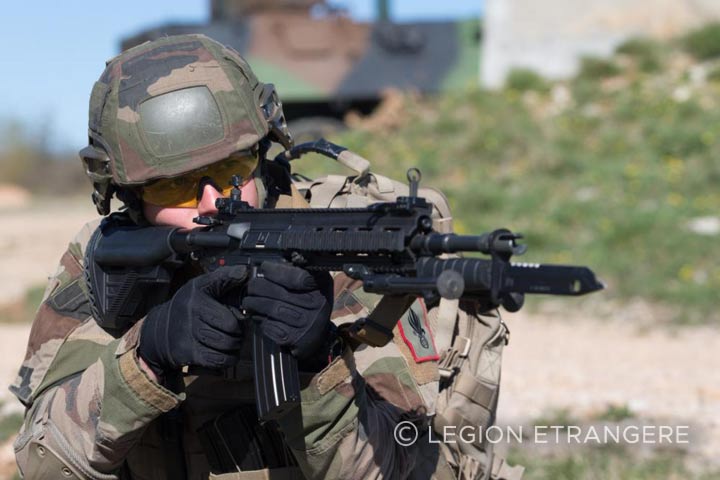
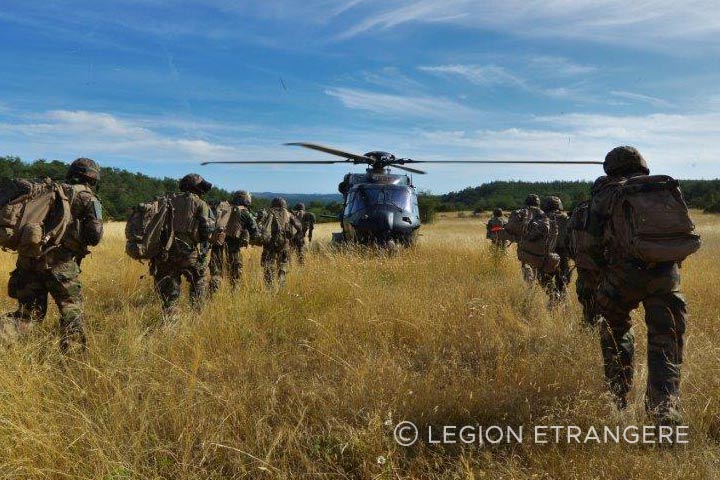


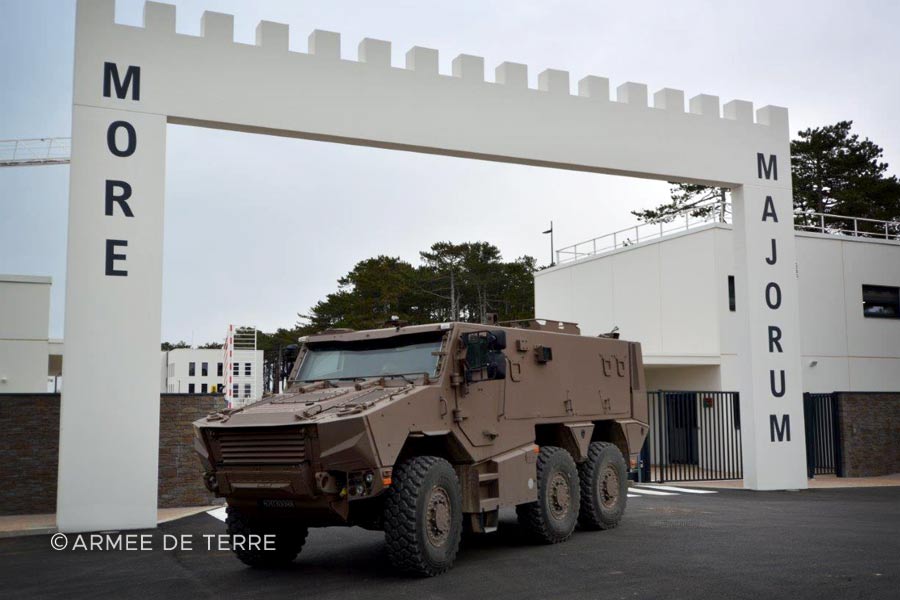



———

———
For current information about the unit, see: 13th Foreign Legion Demi-Brigade
———

Have you enjoyed the article?
You can support this website at any time through our store. Thank you.
EU-based readers can visit our EU-based shop, to avoid import charges.
—
Main information sources:
Képi blanc magazines
Foreign Legion annual bulletins (1950s, 1960s)
Henri Le Mire: L’épopée moderne de la Légion 1940-1976 (SPL, 1978)
Alain Gandy: La Légion en Algérie (Presses de la Cité, 1992)
J. Brunon, G.-R. Manue, P. Carles: Le Livre d’Or de la Légion (Charles-Lavauzelle, 1976)
Ecpad – French Defense Audiovisual Agency
More Majorum – German legionnaires in Indochina 1945-56
Ordre de la liberation (website dedicated to the Liberation of France)
Fanion Vert et Rouge
Google.com
Wikipedia.org
———
More about the history of the Foreign Legion:
History of the 1st Foreign Regiment
History of the 1st Foreign Cavalry Regiment
1st Foreign Parachute Regiment
4th Foreign Infantry Regiment
—
The page was updated on: December 30, 2022
← Back to French Foreign Legion Units
